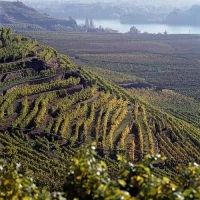Austria's very short 2009 vintage

Here's the interim official report from the Austrian Wine Marketing Board – official but reasonably candid.
And see this forum thread for what happened in the second week in October, just after the first part of the harvest described below.
Mid-harvest report: low quantity, high quality
It was a very hectic time in Austria's vineyards during the last few weeks. The warm and sunny weather until the beginning of October brought healthy grapes with optimal ripeness and – thanks to the cool nights – perfectly preserved aromas and flavours. Once again, a high quality vintage can be expected, albeit this time with just a drop of bitterness: because of bad weather during the flowering period as well as widespread hailstorm damage, a lower harvest volume of -- according Josef Pleil, president of the Austrian Viticulture Association -- approximately 2.2 million hl or less is predicted.
Also in Niederösterreich (Lower Austria), the largest wine-growing area in the country, winemakers are pleased with the high quality of the grapes harvested. For now, total harvest yield estimates continue to decline. Along with the difficult flowering period – cold weather and rain lead to low pollination -- fruit set, especially in the Weinviertel, was lower than in previous years. Heavy rain in the Kremstal, Kamptal and Wachau areas in mid-September resulted in a higher onslaught of fungus, thus demanding rigorous selection during the harvest.
The conditions for grape ripening in Burgenland were ideal in recent weeks. Most of Burgenland was spared from hailstorms this year, although there were some occurrences of poor fruit set (couloure), resulting in low harvest yields. The Fall season delivered warm, dry days and cold nights, which promoted a very good aroma and flavour development in the grapes and helped ensure that they were healthy and fully ripe. The dry weather at the end of August and the beginning of September resulted -- just like in Niederösterreich -- in a smaller quantity of juice for vinification. Presently, most of the harvest here has been completed, except for some red wine varieties and the sweet wines.
The Steiermark (Styria) delivers a resounding 'less, but good' as well. Especially here, heavy rain and cold temperatures during flowering lead to a markedly reduced fruit set, above all for the varieties Weißburgunder (Pinot Blanc), Morillon (Chardonnay) and Sauvignon Blanc. Moreover, according to hail insurance firms, nearly 1,500 hectares were affected in some way by hailstorms. After a wet Summer, the winemakers enjoyed beautiful Autumn weather conditions, which promoted physiological ripeness – the optimal condition of the grapes that reflects not only the sugar and acidity content, but also the aromas and the ripeness of the grape seeds (tannins) and grape skins.
In Vienna, hailstorms in July destroyed the majority of the grapes on the Nussberg, the best site in the Vienna wine-growing area. Of course this means that a low quantity is expected as well, although fruit set complications here were far less extensive than in other areas of the country. In the sites that were spared from hail, winemakers were able to gather beautiful, healthy grapes with good acidity and aromas.
'Despite the hail and difficulties with the fruit set, we can look forward to a highly interesting quality vintage of white wines as well as red wines', said Willi Klinger, general manager of the Austrian Wine Marketing Board.
Become a member to view this article and thousands more!
- 15,430 featured articles
- 274,108 wine reviews
- Maps from The World Atlas of Wine, 8th edition (RRP £50)
- The Oxford Companion to Wine, 5th edition (RRP £50)
- Members’ forum
- 15,430 featured articles
- 274,108 wine reviews
- Maps from The World Atlas of Wine, 8th edition (RRP £50)
- The Oxford Companion to Wine, 5th edition (RRP £50)
- Members’ forum
- Commercial use of our Tasting Notes
